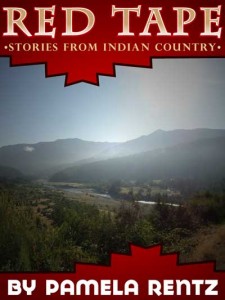This is the ninth interview and the eleventh post in my series on inclusivity and exclusivity in fiction. You can find a full list of other posts so far at the end of this piece.
In today’s interview we talk with author Pamela Rentz, a member of the Karuk Tribe.
 LUC: As both a member of a California tribe and a SF writer who writes Indian characters, what needs do you see in SF–or in literature in general–for growth or change? What’s broken right now in regard to Indian characters in fiction?
LUC: As both a member of a California tribe and a SF writer who writes Indian characters, what needs do you see in SF–or in literature in general–for growth or change? What’s broken right now in regard to Indian characters in fiction?
PAM: When Indian characters show up in stories, too often it’s to act out a narrowly defined role that’s about being Indian. They have to have names with hawk or eagle or bear in them. Some sort of personal spiritual quest is involved. In spec fiction they have to be shapeshifters. To be fair, I remember reading a great story, I think in F&SF, that featured a terrific Indian character and I’ve just spent about fifteen minutes trying to track down the author and title with no luck. But I still see a lot of the magical indigenous person, the spiritual wise one, the romanticized historical Indian. Or, who would have predicted this would develop in my lifetime: the casino Indian. Even in journalism I see the same tired narrative: a non-Indian person has managed to secure the trust of a group of Indians and via this special access is able to share his non-Indian perspective of what “real” Indians are like. The resulting story generally shows terrible poverty and/or something spiritual and exotic.
Where are the Indian detectives and librarians and space mission leaders and zombie hunters?
I’ve been asking myself what needs to happen to bring out more variety and depth to Indian characters and I’ve love to see more Indian writers telling their stories. I’m not suggesting that non-Indians can’t write Indian characters and especially the speculative fiction community tends to be better informed and more likely to do their homework. But, unless you’ve spent some time around Indian people it’s going to be difficult to capture the depth of characterization and unique Indian perspective I feel is missing.
I’m definitely seeing more Indian kids in social media and showing off great talent merging the traditional with the contemporary in fashion, music and art. I’m not aware of much fiction but I’m hoping it’s happening out there somewhere.
LUC: Why do you think that so many writers fall into the trap of Indians as keepers of some kind of secret knowledge or experience that reflects “real” Indians when, ironically, by doing that they’re ignoring the experiences of real real Indians?
PAM: That’s a terrific question. I wonder that myself.
I think part of it is that, not just writers, but most people don’t spend a lot of time with Indian people. I’m trying to figure out the best way to clarify this. Indian identity can be a touchy subject and I’m not trying to pick any fights here. What I’m talking about is spending time with Indians in connection with their Indian communities. Its one thing to have a friend or colleague who’s Indian and another thing to spend time in Indian Country.
Indian communities tend to be isolated and often not especially welcoming to outsiders. It’s tough to get an idea of the culture without seeing the tribal connections. I don’t feel like I really got it until I began working in Indian Country and seeing people from different tribes interacting and similarities in behavior. Things that I saw in my family but never connected to a bigger picture. As a writer, how can you give the Indian an authentic role without observing it yourself?
But then, why not see Indians like everyone else? There are Indian lawyers and school teachers and insurance adjusters. I don’t watch Law & Order but I understand that when Adam Beach (Saulteaux First Nations) was brought on the show his character was a detective who happened to be Indian not they needed an Indian character so they hired him. I saw Wes Studi (Cherokee) in a role once that wasn’t specifically Indian. In movies it seems like Indians show up because they need an Indian, but rarely because the appropriate actor happened to be an Indian. Of course, if you have a character and you cast them as Indian for no reason other than to be diverse, I guess that fails, too.
I think writers fall into traps with Indians for the same reason we often fall into traps when we’re inventing any kind of character. It’s an easy shortcut. The stereotype is universally understood. Why go through the trouble of inventing an Indian character if she’s just going to be turned into a zombie or be the guy on the space ship who says, “Yes, Captain”? You have a noble hero or a badass elder, why not have them save the day with some mystical Indian knowledge?
Every once in awhile I’ll see a description or discussion of something that is “typical Native American.” For example, Native American religion or Native American food. That’s like referring to European religion or European food. It might have value as a general shorthand, but really it’s meaningless. There are over 500 tribes and Alaska Native villages recognized by the US government. There are even more entities that don’t have federal recognition. They’re all unique and most of them don’t conform to stereotype.
LUC: I hope you’ll excuse me for referring to the vampire elephant in the room, but what’s your reaction to the Quileutes in the Twilight books and movies? I can’t help but notice they check off the “shapeshifter” point handily.
PAM: Well, I didn’t hate all of it.
What I liked is that the story had a small Pacific Northwest Tribe that is relatively unknown. It seems like Indians in stories are almost always from the same Tribes, usually Plains.
And in this story, Indians are introduced as regular people who are friends of Bella’s father. At least initially, their purpose isn’t to be Indian.
I also really liked that the tribal members were connected to their lands – the pact was made to protect the Indian lands.
I can’t remember every detail of the story but to the best of my recollection there was no stereotypical corny spiritual aspect such as a medicine man waving his eagle feathers around or people running off to have a vision quest.
On the other hand, Indians as shapeshifters cancels most of that out. It’s awful to see a Tribe’s origin story appropriated and rendered completely silly and then go on to make piles of money for all kinds of non-Native people. There was even Twilight inspired merchandise with “Quileute” designs.
I wonder if Stephenie Meyer had had any notion of how huge and far-reaching those books would end up, would she have done it differently? No way to know. Generally, I don’t think the dominant culture sees it that way. Urban Outfitters needed to be told that the Navajo Nation wasn’t honored to have their hipster panties named after the Tribe.
I’m not as outraged about Twilight as I might have been. The whole story is pretty dopey and doesn’t pretend to be anything other than entertainment. At least the Indians got to be on the winning side.
 Pamela Rentz is an member of the Karuk Tribe of California and works as a paralegal specializing in Indian Affairs. She is a graduate of Clarion West 2008 and has been published in Asimov’s, Innsmouth Free Press and Yellow Medicine Review. She’s published a collection of short stories called Red Tape Stories from Indian Country available for Kindle and other eReader devices at Smashwords. She can be found online at: www.pamrentz.com.
Pamela Rentz is an member of the Karuk Tribe of California and works as a paralegal specializing in Indian Affairs. She is a graduate of Clarion West 2008 and has been published in Asimov’s, Innsmouth Free Press and Yellow Medicine Review. She’s published a collection of short stories called Red Tape Stories from Indian Country available for Kindle and other eReader devices at Smashwords. She can be found online at: www.pamrentz.com.- 7/27/12 – interview with Leah Bobet
- 7/29/12 – Where Are the Female Villains?
- 8/3/12 – interview with Vylar Kaftan
- 8/9/12 – Concerns and Obstacles (multiple mini-interviews)
- 8/10/12 – James Beamon on Elf-Bashing
- 8/17/12 – Steve Bein on Alterity
- 8/24/12 – Anaea Lay on “An Element of Excitement”
- 9/21/12 – Leah Bobet on Literature as a Conversation
- 11/2/12 – Aliette de Bodard on Crossing Over
- 11/9/12 – Anatoly Belilovsky on Atrocities and Menschkeit


